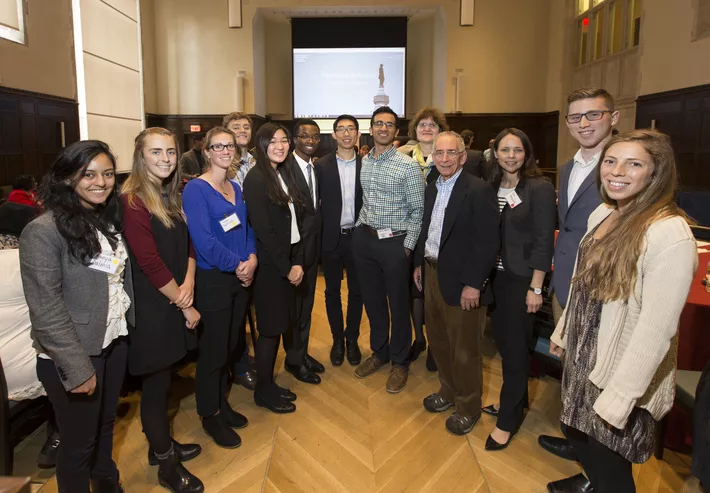Swarthmore Team Striving to Align Behavioral Economics with Public Policy

Swarthmore faculty, students, and an alumnus co-organized a behavioral science workshop in Philadelphia in May that initiated a conversation with the city's public policy makers.
Public policy tends to be written for people who approach everything rationally, like Spock from Star Trek. But most of us are more like Homer Simpson.
“Relative to the purely rational standard, we make lots of mistakes,” says Syon Bhanot, assistant professor of economics. “We grab the donut that’s put right in front of us, we don’t save enough for retirement, we stuff the credit card disclosure in a sock drawer.”
So how do you design policy that reflects the way people actually behave? Bhanot is among a group of behavioral economists working on the answer. He collaborates with the likes of The World Bank, The United States Agency for International Development, The White House Social and Behavioral Science Team, Google, and municipal leaders to apply behavioral economics to real-world problems.
Earlier this year, Bhanot co-founded the Philadelphia Behavioral Science Initiative (PBSI) with Evan Nesterak '09 and academics from the Harvard Kennedy School and the University of Pennsylvania. In May, PBSI organized a behavioral science workshop for government officials from Philadelphia. The mission of the event, which was co-sponsored by The Lang Center for Civic & Social Responsibility: to initiate a two-way conversation between policy makers and academics on the importance of behavioral forces in the city, with the goal of informing policy to change the behavior for the better.
“We wanted to bring policy makers to the table to gain an understanding of what they deal with,” says Bhanot. “This is a collaborative project between academics and the government to make policies that will work better for people.”
For example, city officials want to increase applications for the earned income tax credit (EITC), a federal program supporting incomes for low-income, working Americans. By filling out a simple form, a resident who qualifies can receive a tax credit of up to $6,000. Still, many don’t bother.
“A lot of people just don’t like filling out forms,” says Bhanot. “They can be confusing and overwhelming. It's not rational for a simple form to keep them from claiming the credit, but the reality is that this is a major barrier.”
Simplifying the process is key, he says.
“Some of these improvements we discussed would be very cheap to implement and could have a major effect on budgets and the uptake of hugely beneficial programs and budgets,” says Bhanot. “It’s a win-win for everyone — we just need to find ways to make them work.”
Bhanot began teaching at Swarthmore this fall, and he co-taught a course on behavioral science and public policy with Barry Schwartz, the Dorwin Cartwright Professor of Social Theory and Social Action, in the spring. Through Schwartz, Bhanot met Nesterak, a co-founder of The Psych Report and researcher at the Character Lab of Angela Duckworth at the University of Pennsylvania. Susanne Schwarz from the Harvard Kennedy School and Dan Hopkins from UPenn joined the conversation as well, giving rise to PBSI.
“We realized we were working on a lot of the same things,” says Bhanot, “and we decided to join forces on the first pass of a conference.”
Antonia Violante ’16, a psychology major from Troy, Mich., and also an author at The Psych Report, led a team of Swarthmore students who handled the workshop's logistics and observed discussions.
“The problems being presented [by city officials] reinforced the idea that public policies may be great on paper but not in practice,” says Guihyun Byon ’19, of La Habra, Calif. “[But by applying] behavioral science tools, city officials can approach these policies from a new light.”
“It was great to see behavioral science in action,” adds Seth Stancroff ’19, of Ann Arbor, Mich. “It made me extremely hopeful for the future and helped me realize the potential applications of the behavioral sciences on a grand scale.”
The delegation from the city found the experience eye-opening, as well, Bhanot says, and there are plans for a follow-up conference in the fall — “more of a deep dive with the government folks who are ready to try some of this stuff out experimentally.”
The student team was composed of students from Bhanot's behavioral science course, as well as research assistants (RAs) from a behavioral economics lab he formed on campus. The lab effectively started on the day Bhanot interviewed at Swarthmore, when Stephanie Kestelman ’16, an Honors economics major from Scarsdale, N.Y., told him that she wanted to be his research assistant. The RA team quickly expanded to 14 members.
“I didn’t recruit anyone — they all sort of just showed up,” says Bhanot.
The research assistants mostly helped Bhanot with his own research, but his vision is for the lab to stoke student research efforts as well. Bhanot is working closely with six students on campus this summer, as well as two students doing summer internships (with financial support from the Lang Center) at the Busara Center for Behavioral Economics in Kenya, where Bhanot is an academic affiliate.
“Experiential work in the field with real-life partners is clearly in demand, and it fits into the ethos of Swarthmore,” Bhanot says. “Being thoughtful about policy and helping people appeals to those who want to get out there and do something.
"The Lang Center, in particular, has been a great partner in promoting this kind of work on campus," he adds. "I am looking forward to working with them and others to continue to grow these efforts and build a behavioral science community on campus, in the city, and beyond."



